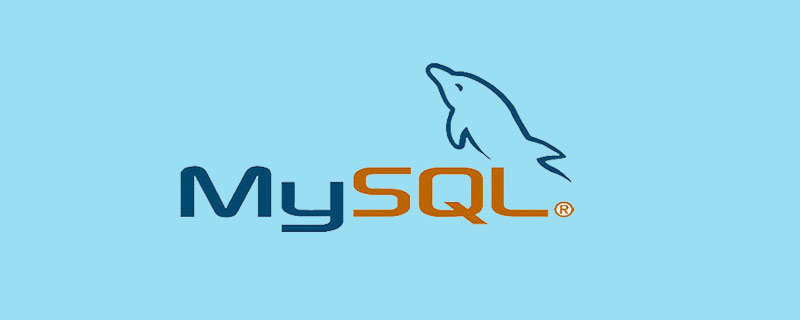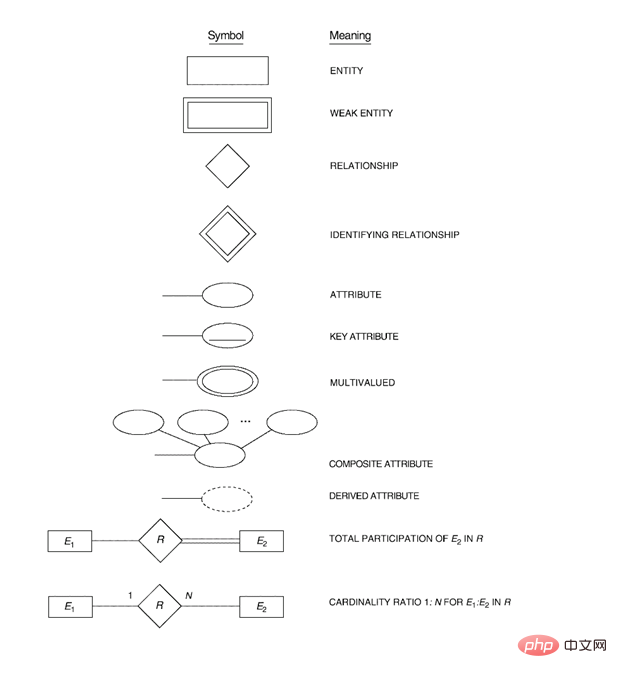What are the basic knowledge points of database principles?
Basic knowledge points on database principles include: 1. Two-level mapping and physical and logical independence of the database system; 2. The difference between controlled redundancy and non-controlled redundancy; 3. The difference between relationships and files or tables ; 4. Relational algebra; 5. Database paradigm, etc.

##More related free learning recommendations: mysql tutorial(Video)
The basic knowledge points of database principles are:
Noun accumulation:
Database (Database): the "warehouse" that stores and provides dataData (Data): the basic objects stored in the database. Database Management System (DBMS): A layer of data management software located between the user and the operating system. Database System: including database, DBMS, application system, database administrator (DBA) Primary Key: used to uniquely identify a record in the table An attribute or collection of attributes. Foreign Key: Used to associate with another table. The foreign key is the primary key of another table. Super Key: A super key can uniquely distinguish Attributes of tuples or collections of attributes keys (candidate keys): redundant attributes in super keys are removed, and different tuples can still be distinguished. Schema: A description of a database, including the database structure, data types, and constraints. Instance (Instance/State): the real data stored in the database at a certain moment. (Instance is the concretization and instantiation of Schema at a certain moment)Data Manipulation Language (DML: Data Manipulation Language): Add, Delete, Modify and CheckData Definition Language (DDL: Data Definition Language ): Define, delete, and modify objects in the databaseData Control Language (DCL: Data Control Language): Used to control user permissions to manipulate the databaseData Model (Data Model): An abstraction of real-world data characteristics, used to define how data is organized and how the relationships between data are Union Compatibility (Union Compatibility): Two relationships must have the same attributes to be compatible. Number, and the same domain for each attributeView (VIEW): A view is a virtual table, not physically stored data. Rather, it is data derived from underlying tables or other views. Updates to the view are actually translated into updates to the actual base tables.Data Model:
Basic concept: The abstraction of real-world data characteristics, used to define how data is organized and what the relationship between data is. Level: 1. Conceptual model (Conceptual): Model data and information from the user’s perspective 2. Logical / Implementation model (Logical / Implementation) : Hierarchical model, network model,Relational model
3. Physical model (Physical): The physical storage method of data in specific DBMS productsDatabase The three-level schema structure of the system:

2. Conceptual Schema: (Also called global schema.) Sometimes referred to as "schema". It is a
description of the logical structure and characteristics of all data in the database3. External Schema
s): (also called sub-schema or user schema. )Description of the logical structure and characteristics of local data that database users can see and use
Two-level mapping and physical and logical independence of the database system:Two-level mapping:
1. Conceptual schema/internal schema mapping
2.External schema/conceptual schema mapping
Physical independence of data:
The mapping between the internal schema and the conceptual schema provides the physical independence of the data. When the physical structure of the data changes, only the mapping between the internal schema and the conceptual schema needs to be modified.
Logical independence of data:
The mapping between the conceptual schema and the external schema provides the logical independence of the data. When the overall logical structure of the data changes, only the mapping between each external schema and the conceptual schema needs to be modified to ensure that the application is not affected.
Data constraints: integrity constraints1. Domain constraints: constraints on attribute value range
2. Key constraints: each Each relationship must have a primary key, and each primary key must be different
3. Non-null constraint: attribute value cannot be NULL
4. Entity integrity constraint: primary key value cannot be null
5. Referential integrity constraints: The foreign key can take a NULL value, but if the foreign key is the primary key of another relationship, it cannot be NULL.
6. User-defined integrity
Various data operations may violate's integrity constraints
Insertion operations: domain constraints, key constraints, Non-null constraints, entity integrity constraints, referential integrity constraints
Delete operations: referential integrity constraints
Update operations: domain constraints, key constraints, non-null constraints, entity integrity constraints, Referential integrity constraints
SQL statement execution sequence:
1. FROM clause assembles data from different data sources
2. WHERE clause Filter records based on specified conditions
3. GROUP BY clause divides data into multiple groups
4. Use aggregate functions for calculation
5. Use HAVING Clause filter grouping
6. Calculate all expressions
7. Use ORDER BY to sort the result set
Controlled Redundancy and The difference between Uncontrolled Redundancy:
Uncontrolled data storage redundancy will cause the following problems:
1. Duplicate work when updating data
2. Waste of space
3. Data may be inconsistent
So, ideally, we should design a database without redundancy, but sometimes we need to improve the query Efficiency, so we introduced Controlled Redundancy
For example:
We redundantly store student names and course numbers in the GRADE_REPORT table, because when querying scores we need to query them at the same time Student name and course number.
The difference between Relation and files or tables:
Relationship looks like a two-dimensional table
Relationship The domain (the value range of the attribute) is a set of atomic values (non-redivisible values)
The tuples in the relationship must be different
Relational algebra:
Five basic operations: union, difference, Cartesian product, selection, projection
Relational algebra interpreter: Relational algebra interpreter (simulating relational algebra)
Inner join Types:
1. Equivalent join
2. Unequal join
3. Natural join
SQL statement:
Copy of table structure (excluding relationships between tables)
SELECT * INTO COPY_DEPARTMENT FROM DEPARTMENT WHERE 1=0;
Three-valued predicate logic:
1. TRUE
2. FALSE
3. UNKNOWN
It is only determined to be true if the comparison result is TRUE, e.g. ( The intersection of TRUE and UNKNOWN is UNKNOWN, and this tuple will not appear in the result)
Basic process of database application system design:
Phases of Database Design andImplementation Process( The basic process of database design)
Phase 1:Requirements Collections and Analysis(requirements collection and analysis)
Phase 2:Conceptual Database Design(conceptual structure design)
Phase 3 :Choice of a DBMS(choose the appropriate DBMS)
Phase 4:Data Model Mapping (Logical Database Design)(logical structure design)
Phase 5:Physical Database Design(physical structure design)
Phase 6:Database System Implementation(database implementation)
Phase 7:Database System Operation and Maintenance(database operation and maintenance)
ER diagram symbol explanation:

Steps to map ER model into logical model:
1. Mapping strong entity type
2. Mapping weak entity type
3. Mapping 1: 1 binary relationship type
4. Mapping 1: N binary relationship type
5. Mapping M : N-binary relationship
6. Mapping multi-valued attributes
7. Mapping N-ary relationship
Database paradigm:
1NF (First Normal Form): If and only if all fields contain only atomic values, that is, each component is an irreducible data item, then the entity E is said to satisfy the first normal form
2NF (Second Normal Form): If and only if entity E satisfies the first normal form, and each non-key attribute completely depends on the primary key, it satisfies the second normal form
3NF (Third Normal Form): If and only if the entity E is the first normal form When it is in second normal form (2NF) and there is no non-primary attribute transitive dependency in E, it satisfies the third normal form
The above is the detailed content of What are the basic knowledge points of database principles?. For more information, please follow other related articles on the PHP Chinese website!

Hot AI Tools

Undresser.AI Undress
AI-powered app for creating realistic nude photos

AI Clothes Remover
Online AI tool for removing clothes from photos.

Undress AI Tool
Undress images for free

Clothoff.io
AI clothes remover

AI Hentai Generator
Generate AI Hentai for free.

Hot Article

Hot Tools

Notepad++7.3.1
Easy-to-use and free code editor

SublimeText3 Chinese version
Chinese version, very easy to use

Zend Studio 13.0.1
Powerful PHP integrated development environment

Dreamweaver CS6
Visual web development tools

SublimeText3 Mac version
God-level code editing software (SublimeText3)

Hot Topics
 1378
1378
 52
52
 How do you alter a table in MySQL using the ALTER TABLE statement?
Mar 19, 2025 pm 03:51 PM
How do you alter a table in MySQL using the ALTER TABLE statement?
Mar 19, 2025 pm 03:51 PM
The article discusses using MySQL's ALTER TABLE statement to modify tables, including adding/dropping columns, renaming tables/columns, and changing column data types.
 Explain InnoDB Full-Text Search capabilities.
Apr 02, 2025 pm 06:09 PM
Explain InnoDB Full-Text Search capabilities.
Apr 02, 2025 pm 06:09 PM
InnoDB's full-text search capabilities are very powerful, which can significantly improve database query efficiency and ability to process large amounts of text data. 1) InnoDB implements full-text search through inverted indexing, supporting basic and advanced search queries. 2) Use MATCH and AGAINST keywords to search, support Boolean mode and phrase search. 3) Optimization methods include using word segmentation technology, periodic rebuilding of indexes and adjusting cache size to improve performance and accuracy.
 How do I configure SSL/TLS encryption for MySQL connections?
Mar 18, 2025 pm 12:01 PM
How do I configure SSL/TLS encryption for MySQL connections?
Mar 18, 2025 pm 12:01 PM
Article discusses configuring SSL/TLS encryption for MySQL, including certificate generation and verification. Main issue is using self-signed certificates' security implications.[Character count: 159]
 What are some popular MySQL GUI tools (e.g., MySQL Workbench, phpMyAdmin)?
Mar 21, 2025 pm 06:28 PM
What are some popular MySQL GUI tools (e.g., MySQL Workbench, phpMyAdmin)?
Mar 21, 2025 pm 06:28 PM
Article discusses popular MySQL GUI tools like MySQL Workbench and phpMyAdmin, comparing their features and suitability for beginners and advanced users.[159 characters]
 How do you handle large datasets in MySQL?
Mar 21, 2025 pm 12:15 PM
How do you handle large datasets in MySQL?
Mar 21, 2025 pm 12:15 PM
Article discusses strategies for handling large datasets in MySQL, including partitioning, sharding, indexing, and query optimization.
 Difference between clustered index and non-clustered index (secondary index) in InnoDB.
Apr 02, 2025 pm 06:25 PM
Difference between clustered index and non-clustered index (secondary index) in InnoDB.
Apr 02, 2025 pm 06:25 PM
The difference between clustered index and non-clustered index is: 1. Clustered index stores data rows in the index structure, which is suitable for querying by primary key and range. 2. The non-clustered index stores index key values and pointers to data rows, and is suitable for non-primary key column queries.
 How do you drop a table in MySQL using the DROP TABLE statement?
Mar 19, 2025 pm 03:52 PM
How do you drop a table in MySQL using the DROP TABLE statement?
Mar 19, 2025 pm 03:52 PM
The article discusses dropping tables in MySQL using the DROP TABLE statement, emphasizing precautions and risks. It highlights that the action is irreversible without backups, detailing recovery methods and potential production environment hazards.
 How do you create indexes on JSON columns?
Mar 21, 2025 pm 12:13 PM
How do you create indexes on JSON columns?
Mar 21, 2025 pm 12:13 PM
The article discusses creating indexes on JSON columns in various databases like PostgreSQL, MySQL, and MongoDB to enhance query performance. It explains the syntax and benefits of indexing specific JSON paths, and lists supported database systems.




